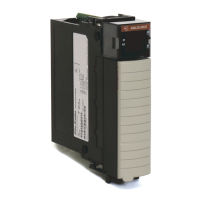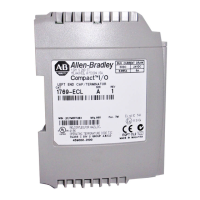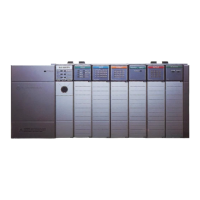
Do you have a question about the Allen-Bradley 1756-OB16IEFS and is the answer not in the manual?
| Category | I/O Systems |
|---|---|
| Number of Outputs | 16 |
| Output Type | Sourcing |
| Voltage Category | 24V DC |
| Total Current Rating | 8A |
| Series | 1756 |
| Module Type | Digital Output |
| Product Type | Output Module |
| Voltage Range | 10-30V DC |
| Isolation Voltage | 250V |
| Isolation Voltage Continuous | 250V |
| Operating Temperature | 0 to 60°C |
| Special Features | Electronic Fuse |
| Certifications | CE, UL, cUL |
Introduces the Studio 5000 Engineering and Design Environment for ControlLogix.
Details how ControlLogix I/O modules are owned by RSLogix 5000 controllers.
Describes how input modules multicast data via Change of State or RPI.
Covers how owner-controllers send output data to modules.
Explains how RSLogix 5000 software configures module features and retrieves information.
Details the electronic keying feature for preventing communication with mismatched modules.
Explains how to suspend module connections for maintenance without removing them.
Details using Coordinated System Time (CST) for timestamps in standard I/O modules.
Explains using CIP Sync for timestamps and scheduling in fast I/O modules.
Explains data transfer methods using RPI and Change of State (COS).
Details how to enter a Requested Packet Interval (RPI) value in module properties.
Guides on enabling or disabling Change of State (COS) for input transitions.
Explains configuring unique output states for Program or Fault modes.
Explains internal electronic or mechanical fusing for output module protection.
Explains diagnostic latching to retain fault status even after the condition disappears.
Details how diagnostic I/O modules can timestamp faults or clears for accuracy.
Explains how diagnostic I/O modules set bits to indicate point-by-point faults.
Describes how diagnostic input modules send data on event changes like RPI or COS.
Details the feature to verify field wiring connection by detecting open wires.
Explains the feature for detecting loss of field power on output modules.
Covers the feature sensing absence of field wiring or load when output is Off.
Explains how the module verifies logic-side instructions are represented on the power side.
Describes the Pulse Test feature for verifying output circuit functionality without changing load state.
Explains how diagnostic output modules send new data on event changes.
Details screw-to-backplane response times for fast input and output modules.
Explains detecting or latching short duration pulses with fast input modules.
Details recording timestamps for input transitions in CIP Sync format.
Explains configuring input filter times to account for contact bounce.
Covers initiating event tasks using user-defined input patterns with fast modules.
Allows defining duration and final state for outputs in Fault mode due to communication failure.
Explains precise onboard control of output pulse trains using PWM.
Covers limiting the number of pulse cycles or executing all cycles regardless of logic state.
Guides on configuring Pulse Width Modulation (PWM) parameters for output points.
Explains how fast input modules multicast fault and status data to controllers.
Explains how fast output modules multicast fault and status data to controllers.
Describes how to install or remove ControlLogix I/O modules while chassis power is applied (RIUP).
Provides information for operating equipment in hazardous locations.
Details compliance with EU directives for use in potentially explosive atmospheres.
Explains how to key the RTB to prevent incorrect wiring connections to the module.
Guides on connecting wires to Removable Terminal Blocks (RTBs) or Interface Modules (IFMs).
Provides steps to install the RTB onto the module to connect wiring.
Guides on how to remove the RTB from the module.
Guides on adding a new local or remote I/O module in RSLogix 5000 software.
Illustrates using ladder logic for fuse reset, pulse tests, and latched diagnostics.
Shows retrieving module identification and status information via a WHO service.












